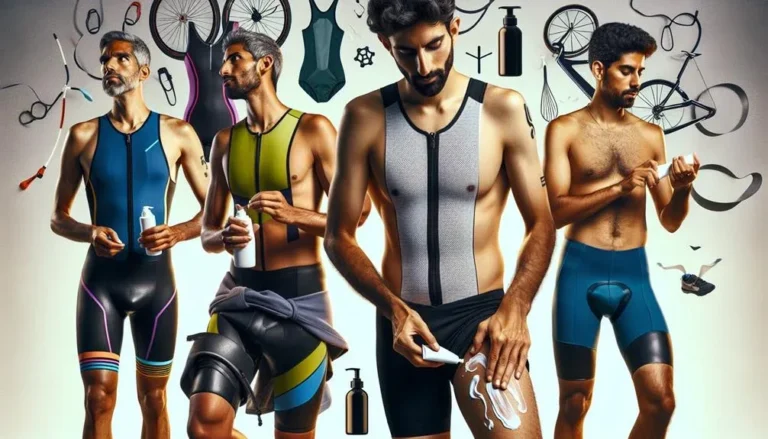Like a persistent shadow on a sunny day, chafing can cast a pall over a triathlete’s performance, hindering their stride towards the finish line. But fear not, for in this guide, I will unveil the secrets to banishing chafing woes and reclaiming the joy of the race.
Through expert advice on swimwear selection, wetsuit and tri-suit fitting, saddle fit, lubrication techniques, and more, you’ll gain the tools needed to conquer chafing and emerge victorious in your triathlon pursuits.
So, prepare to unlock the key to a smoother, more comfortable race experience.
Key Takeaways
- Choose quick-drying, well-fitted gear.
- Ensure proper saddle fit to prevent chafing.
- Use sport-specific lubricants for protection.
- Protect healing areas and vulnerable spots.
Swimwear Selection Tips
When selecting swimwear for triathlons, it’s crucial to opt for quick-drying and soft materials to prevent chafing issues. Look for suits with strategically placed seams and finishes that won’t cause irritation during long races.
Consider your body shape and how the suit moves with you to ensure comfort and minimal chafing. Pay special attention to areas like the armpits and groin, where creasing can lead to discomfort.
Check the chamois size and seam placement for added comfort during the bike portion of the race. By choosing the right swimwear made of high-quality materials, you can focus on your performance without the distraction of chafing problems, ultimately enhancing your overall triathlon experience.
Wetsuit and Tri-Suit Fitting
For optimal comfort and performance in triathlons, ensuring a proper fit of both the wetsuit and tri-suit is essential.
- Check wetsuit neck firmness to prevent chafing.
- Remember tri-suit may feel tight dry but fit well wet.
- Avoid excessively tight or loose fits in both suits.
- Think about how movement impacts suit fit.
- Women should prioritize a well-fitting sports bra.
Saddle Fit Importance
Understanding the critical role of saddle fit in preventing chafing is paramount for triathletes aiming for comfort and peak performance. A well-fitted saddle ensures that pressure is evenly distributed, reducing the risk of chafing during long rides.
It’s essential to consider the width and angle of the saddle to match your body geometry and riding style. Incorrect saddle fit can lead to discomfort and chafing in sensitive areas, impacting your performance.
Before choosing a tri-suit, make sure that your saddle is properly adjusted to minimize friction and rubbing. Don’t overlook the importance of saddle fit, as it can make a significant difference in your overall riding experience and comfort on the bike.
Lubrication Techniques
Saddle fit plays a crucial role in preventing chafing during triathlons, and now let’s explore effective lubrication techniques to further enhance comfort and performance. Using the right lubricant is key to preventing chafing and ensuring a smooth race experience.
Here are some tips for effective lubrication:
- Choose sport-specific lubricants like Body Glide.
- Apply generously to areas prone to chafing.
- Consider using petroleum jelly as an alternative.
- Focus on applying lubricant to seams, fold points, and the crotch area.
- Utilize lubrication to facilitate easy wetsuit removal.
Protection Strategies for Chafing
To shield against chafing discomfort during your triathlon endeavors, I recommend implementing proactive protection strategies.
Start by choosing swimwear with quick-drying, soft fabric and strategic seam placement. Consider your body shape and movements to prevent creasing in areas like the armpits and groin. Ensure your wetsuit fits snugly around the neck and your tri-suit fits well when wet.
Pay attention to saddle width and angle for even pressure distribution. Use sport-specific lubricants generously on chafing-prone areas and protect healing chafed areas with KT Tape. Remember to lubricate ankles and toes for easy wetsuit removal.
Healing and Preventing Chafed Areas
To combat chafing discomfort effectively in triathlons, understanding how to heal and prevent chafed areas is crucial for ensuring a smooth race experience. Here are some tips that can help:
- Keep the chafed area clean and dry to promote healing.
- Apply a soothing cream or ointment to aid in recovery.
- Use breathable bandages or dressings to protect the chafed skin.
- Wear loose-fitting clothing to prevent further irritation.
- Stay hydrated to support the body’s natural healing process.
Conclusion
As triathletes, we must navigate the rough waters of chafing to reach the smooth shores of success. Just as we fine-tune our gear and technique for optimal performance, banishing chafing requires attention to detail and proactive measures.
By treating chafing like a relentless opponent on the course, we can conquer it with determination and strategy.
Let’s lace up our shoes, dive in, and leave chafing woes in our wake as we race towards victory.
